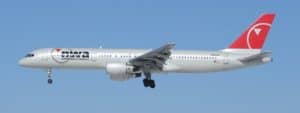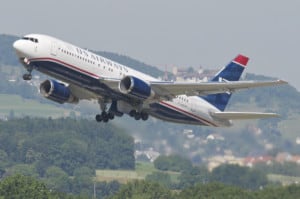When it comes to airplanes, there are two main types: the 757 and the 767. The 757 is a smaller plane, while the 767 is a larger one. Some people prefer flying on a 757 because it’s more intimate – you can see the pilot’s face! But others prefer the spaciousness of a 767.
I’m a big fan of both planes. But because of the debate, I will break down the main differences between them. Read on!
| Aircraft: | Boeing 757-200 | Boeing 767-200 |
|---|---|---|
| Photo: |
 |
 |
| Country: | United States | United States |
| Manufactured: | from: 1982 to: 2005 | from: 1982 to: 1994 |
| ICAO: | B752 | B762 |
| Price: | $65 million | $160.2 million |
| Avionics: | Rockwell Collins CRT | - |
| Engine: | 2x Pratt & Whitney PW2037 | 2x General Electric CF6-80C2, Pratt & Whitney JT9D |
| Engine Type: | Turbofan | Turbofan |
| Power: | 42,600 pound-force | 60,600 pound-force |
| Max Cruise Speed: |
496 knots 919 Km/h |
493 knots 913 Km/h |
| Approach Speed (Vref): | 140 knots | 135 knots |
| Travel Range: |
3,915 Nautical Miles
7,251 Kilometers |
6,590 Nautical Miles
12,205 Kilometers |
| Fuel Economy: | - |
0.27 nautical mile / gallon 0.132 kilometres / litre |
| Service Ceiling: | 42,000 feet | 43,199 feet |
| Rate of Climb: |
3500 feet / minute 17.78metre / second |
2000 feet / minute 10.16metre / second |
| Take Off Distance: |
2070 metre 6,791.26 feet |
1707 metre 5,600.33 feet |
| Landing Distance: |
1400 metre 4,593.12 feet |
1219 metre 3,999.30 feet |
| Max Take Off Weight: |
99,800 Kg 220,019 lbs |
142,882 Kg 314,998 lbs |
| Max Landing Weight: |
89,800 Kg 197,973 lbs |
123,377 Kg 271,997 lbs |
| Max Payload: |
25,920 Kg 57,143 lbs |
33,271 Kg 73,349 lbs |
| Fuel Tank Capacity: |
11,276 gallon 42,684 litre |
16,700 gallon 63,216 litre |
| Baggage Volume: |
47 m3 1,660 ft3 |
86.9 m3 3,069 ft3 |
| Seats - Economy: | 239 seats | 290 seats |
| Seats - Business Class: | - | 224 seats |
| Seats - First Class: | - | 181 seats |
| Cabin Height: |
2.1 metre 6.89 feet |
2.10 metre 6.89 feet |
| Cabin Width: |
3.5 metre 11.48 feet |
4.7 metre 15.42 feet |
| Cabin Length: |
38.3 metre 125.65 feet |
33.93 metre 111.32 feet |
| Exterior Length: |
47.3 metre 155.18 feet |
48.5 metre 159.12 feet |
| Tail Height: | 13.6 metre - 44.62 feet | 16.13 metre - 52.92 feet |
| Fuselage Diameter: |
3.8 metre 12.47 feet |
5.03 metre 16.50 feet |
| Wing Span / Rotor Diameter: |
38 metre 124.67 feet |
47.6 metre 156.17 feet |
| Wing Tips: | No Winglets | No Winglets |
| More Info: | Boeing 757-200 | Boeing 767-200 |
|
Data presented is for entertainment purposes and should not be used operationally.
|
Other Boeing 757-200 comparisons:
Other Boeing 767-200 comparisons:
About the Boeing 757
The Boeing 757 is a midsize twin-jet airliner that was first introduced in 1983. It has a top speed of 982 km/h and a range of 7,222 km. The 757 is 38 m long and has a wingspan of 47 m. It typically seats between 210 and 289 passengers, although it can accommodate up to 440 passengers in a high-density configuration.
The 757 is powered by either Rolls-Royce RB211 or Pratt & Whitney PW2000 engines. It has a unit cost of between 80 and 100 million USD. The 757 was initially developed as a replacement for the 727, and it shares many similarities with that aircraft, including its fuselage diameter and two-crew cockpit.
However, the 757 is longer and has larger engines, which gives it more excellent range and fuel efficiency. The 757 has been popular with airlines since its introduction and remains in production today. There have been 1,050 Boeing 757s delivered as of 2013, and the aircraft is operated by over 180 airlines around the world.
Why was it developed and built?
The 757 was developed and built in response to customer demand. Airlines wanted an aircraft that could carry more significant numbers of passengers with increased range, fuel efficiency, and reliability. The 757 provided a medium-sized airliner that could fill the gap between smaller regional aircraft and larger widebody jets. It was designed to be more efficient than the 727, and it has become one of Boeing’s most successful aircraft.
What purpose does it serve?
It serves as an efficient mid-sized passenger airliner. The 757 is used by airlines for short and medium-haul routes, including domestic flights between cities and international flights between continents. It has a good range and fuel efficiency, making it ideal for airlines looking to maximize their profits.
About the Boeing 767
The Boeing 767 is a twin-engine wide-body airliner produced by Boeing Commercial Airplanes. It was developed in collaboration with Aerospatiale and Fairchild Aircraft. The aircraft has two engines, a double-deck configuration, and a capacity of 375 passengers in a mixed-class layout.
The 767 was introduced on 8 September 1982 by United Airlines.
As of July 2013, 768 have been delivered, with Delta Air Lines as the largest operator with 160 aircraft. In 1985, it was selected as the launch platform for the GE CF6 engine. The airplane is commonly used on transcontinental routes and can fly for up to 13 hours non-stop.
The 767 has been operated by many airlines worldwide, including British Airways, Cathay Pacific, Qantas, and Lufthansa. The U.S. Air Force has also used it for aerial refueling missions.
Why was it developed and built?
The 767 was developed and built to provide airlines with a modern, efficient aircraft that would meet their needs for medium-range flights.
The plane was designed to fly further than the 727 and 737 while offering more passenger capacity than either jet. The double-deck configuration allows for more efficient use of the cabin space, and its two engines provide greater fuel efficiency than larger three-engine jets.
What purpose does it serve?
The 767 serves as a medium-range, wide-body airliner that can carry up to 375 passengers. It is used on transcontinental routes and can fly for up to 13 hours non-stop. The U.S. Air Force also uses the 767 for aerial refueling missions.
How are the Boeing 757 and Boeing 767 different?
The Boeing 757 and 767 are twin-engine jets introduced in the 1980s. The 757 was designed as a narrow-body aircraft, while the 767 was designed as a wide-body twin-aisle aircraft.
The main difference between the two types of aircraft is their size; the 757 is typically configured for carrying 200-300 passengers, while the 767 can carry up to 400 passengers. Because of their different sizes, the 757 and 767 have different ranges; the 757 has a range of 3,700 miles, while the 767 has a range of 5,200 miles. Although they are additional aircraft, the 757 and 767 share many standard features, including comparable fuel efficiency and operating costs.
How are the Boeing 757 and Boeing 767 similar?
There are several similarities between the Boeing 757 and the 767. Both aircraft are twin-engine jets introduced in the 1980s; they share many of the same features and components and offer comparable fuel efficiency and operating costs.
Additionally, both have a two-crew flight deck layout and the same engines, with the 757 featuring either Pratt & Whitney or Rolls-Royce engines and the 767 featuring GE or PW engines. The 757 and 767 also have a similar range, with the 757 having a range of 3,700 miles and the 767 having a range of 5,200 miles.
What’s better about the Boeing 757?
Engine:
The Boeing 757 is powered by two high-bypass turbofan engines, a Pratt & Whitney PW2000 or Rolls-Royce RB211. The engines provide improved fuel efficiency and reduced noise levels compared to older-generation aircraft.
Cabin:
The cabin of the 757 is designed to be comfortable and quiet, with improved acoustics, wider aisles, and more legroom. The cabin also features oversized windows for better views, improved lighting, and the latest in-flight entertainment systems.
Avionics:
The 757 also features upgraded avionics, allowing for more straightforward navigation and greater accuracy. The cockpit has been configured to reduce fatigue and improve crew efficiency, with advanced computer systems that can track aircraft performance and alert the crew to potential problems.
What’s better about the Boeing 767?
Development:
The 767 was developed to meet the needs of airlines that needed an efficient and reliable wide-body aircraft. It features a double-deck configuration, allowing for more efficient use of the cabin space, and its two engines provide greater fuel efficiency compared to larger three-engine jets.
Cargo:
The 767 also has greater cargo capacity than the 757, allowing more freight and baggage to be transported. This makes it ideal for airlines that need to transport larger loads.
Technology:
Finally, the 767 also features some of the latest technology, including advanced avionics, an electronic flight deck, and improved navigation systems. This makes it easier for pilots to navigate and fly the aircraft more accurately.
Conclusion
The Boeing 757 and 767 are two efficient and reliable aircraft that were developed to meet the needs of airlines. They help airlines transport passengers and freight around the world safely, efficiently, and in comfort. Choosing the best aircraft for a particular application will depend on the specific needs of the airline.


